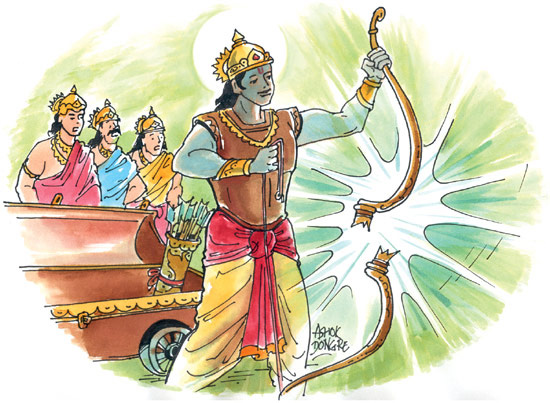Apr 18, 2025
Apr 18, 2025

All the four princes of Ayodhya led by Rama decided to participate in this marriage - Swayamvara - as is known. With great pomp and show, accompanied by their Guru (Teacher), the foursome left for Mithila on one auspicious day.
(A very beautiful account is given regarding the stay of these princess as the guests of Janaka. How accidental meeting of Rama and Sita leads to blooming of love in their bosoms; how Sita vows in heart of her heart to marry Rama and Rama alone, etc.)
And the day of reckoning dawns! One by one the princes from various states and kingdom try their luck in attempting to lift and break that Bow of Shiva. But was that ever possible! Was that ever destined! Even the most powerful amongst all the kings, all over the world, the great Ravana of Lanka could not even move the bow one inch above the ground! Everyone laughed at this tragic show and defeat of Ravana.
Rama Succeeds
At last it was the turn of Rama. With due humility and respect, Rama saluted the Bow (i.e. Shiva Himself), and prayed to give him strength and courage to attempt and succeed in this almost impossible task. In one attempt Rama lifted and set apart the bow in two! The whole Royal Court was filled with shouts of 'Glory Unto Rama, Victory to Rama', etc. However, this made king Ravana jealous and insulted; he mentally vowed to defeat Rama some day if opportunity arose.
Thus, in most wonderful setting, the auspicious marriage of Rama and Sita took place. Along with Rama, his three brothers also got married to the three sisters of Sita. Four sons of King Dasharatha married four daughters of King Janaka!
Now this Sita, as already mentioned, was pious, obedient, intelligent, simple and sober lady; the perfect embodiment of purity in thoughts, words, and deeds. Other than Rama she could not and did not even think of other male. This faithfulness towards one man - husband - is a very special virtue of Indian Womanhood, and Sita is the true representative of this. It is, of course, also imperative that the husband should not think of other woman except his wife. Therefore, it is common in India to look upon and address every woman other than wife as "Mother or Sister".
[At the death of her husband, therefore, it was not unusual to see the widow attempting to immolate herself at the funeral pyre of her husband. Of course, later in medieval India, many instances of widow burning were related to acquisition of ancestral property etc - Sati Tradition. But that was an aberration rather than the rule. Today this system is not in vogue any more.]
Coming back to our story, the joyous marriage procession with decorated chariots, bullock carts, horses and elephants reached Ayodhya. The atmosphere was of celebration and merriment, as if the princes had returned after having won a Great War.
Previous Page | Continue Next Page
21-Aug-2010
More by : Dr. C.S. Shah